íŕ
ăëŕâíóţ
VII. — GENERAL VIEW OF NATURE.
My
studies of the religious life of the Koryak, and of their conception of
the universe, lead me to think that their conception of nature approaches very
closely the ideas of the Indians of the North Pacific coast. At the same time,
however, the religion and the myths of the Koryak contain traces of Asiatic
and Eskimo ideas.
The
Koryak view of nature is most primitive. Not only all visible objects, but
also the phenomena of nature, are regarded as animate beings. This idea
of a vital principle residing in objects and phenomena of nature is essentially
an anthropomorphic idea.
Everything
visible in nature, and everything imaginary, — that is, all that is
within and beyond the limits of our visual powers (as, for example, animals, plants,
stones, rivers, a wind, a fog, a cloud, luminaries, spirits, and deities), —
are
thought of as material beings of anthropomorphic form. These anthropomorphic
ideas are often schematic and incomplete. This is shown by the wooden
images of "guardians." Since the Koryak have attained quite a high
degree of skill in carving figures true to nature, and in endowing them with motion
and life, we cannot help being surprised at the crudeness of the outlines
of their wooden representations of the "guardians." This apparently corresponds
to their vague anthropomorphic notions of invisible objects as they present
themselves to their mind.
On
the other hand, this vagueness of their notions does not prevent them from being
material. To their
minds it is an undoubted fact that objects and phenomena
of nature conceal an anthropomorphic substance underneath their outer forms.
At the period of the appearance of man on earth, — that is, at the time
of Big-Raven, which corresponds to the
mythological age of the Indians
of the Pacific coast of America, — the transformation of animals and other objects into
men was quite a natural occurrence.
All objects appeared in two states.
One corresponded to the exterior form of things, serving as a cover;
and the
other, to
the interior, anthropomorphic form.
Every object may
turn into
a human being by
casting off its outer shell. The
myths of both
the Koryak and the Pacific coast Indians are full of such episodes.
The bear,
the wolf, the fox, the ermine, the mouse, the
raven, and other animals, are described as taking off their
skins and becoming men. In
the same manner -
the
Fog people come out of a dispersing fog,1 and a cloud turns into a Cloud-Man. By casting
off their
hard exteriors, stone
hammers turn
into Stone-Hammer people, who go fishing.3 Fishes,
also, take on the form of human beings.
1
Tale 94.
2
Tale 48.
[II5]
.
116
JOCHELSON,
THE KORYAK.
At
that time, man also possessed the power of transforming himself. By
putting on the skin of an animal, or by taking on the outward form of an
object, he could assume its form. Big-Raven and Eme'mqut turned into
ravens
by putting on raven coats. Kïlu', the niece of Big-Raven, put on a
bear-skin
and turned into a bear.1 Eme'mqut put a dog's skin on his
sister, and she
became a dog.2 Eme'mqut and his wives put on wide-brimmed
spotted hats
resembling the fly-agaric, and turned into those poisonous fungi.3
The belief
in the transformation of men into women after putting on woman's clothes
and vice versa,
is
closely related to this group of
ideas.
The
episodes of the mythological age must be interpreted in the light of
this general anthropomorphic idea of nature. Thus Big-Raven associated
with
animals as though they were human; the Kamchadal Raven (Kutq) had inter-
course with various kinds of inanimate objects to satisfy his lust;4
and Big-
Raven's daughter Yiñe'a-ñe'ut married a fog, a cloud, a
stick, a'tree, birds,
fishes, and other animals.5
When objects assume a human form, or
vice versa, the
incongruity of size
|
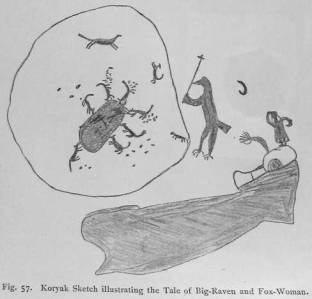
|
in the two states does not
seem to be noticed. The
little ermine or mouse
becomes a man ; a spider
turns
into an old woman ;
and Big-Raven transforms himself, not only into a
raven, but into a reindeer-
hair.6
Although
transforma-tions, or the passing of
objects from one state
into another, are implicitly
believed in, it seems to
be held that some of the
properties characteristic
of one state frequently
remain after the object
has been transformed into
another.
The sketch
|
|
Fig.
57. Koryak Sketch illustrating the Tale of Big-Raven and Fox-Woman |
|
shown
in
Fig. 57,made by the Koryak
Ka'mmake, and representing Big-
Raven
(Uuikinn-a'qu) as a raven, retains some human features, as, for instance,
the upright position and the arms.7
1
Tale 5. 2 Tale
4. 3 Tale
12
4 Steller, p.263
5
See Tales
4,33,47,55,66,81,84,86,114
6 Tale 9
7
This sketch illustrates Tale 96
117
JOCHELSON, THE
KORYAK.
In
one story1 a
man whom Big-Raven made of a wiping-rag has the peculiarity
of constantly moving his bowels; and in other tales2 Raven-Man and
also Big-Raven cannot break away from the raven's habit of devouring excrement.
The Stone-Hammer people retain hard heads. Illa' knocks them against
each other for his amusement.3 One
part of Tale 4 (p.
I 33) is
particularly interesting in this respect. Looking for his sister
Yitie'a-ne'ut, Eme'mqut finds her in the village of the Cloud
people, and notices that the people there, their reindeer,
their houses, the pots that are hanging over the hearth, expand and contract
like clouds.
In
the time of Big-Raven there was no sharp distinction between men, animals,
and other objects; but
what used to be the ordinary, visible state in his
time, became invisible afterward. The nature of things remained the same;
but
the transformation of objects from one state into another ceased to be visible
to men, just as the kalau became invisible to them. Only shamans —
that
is, people inspired by spirits —
are able to see the kalau, and to observe
the transformation of objects. They are also able to transform themselves
by order of the spirits, or in accordance with their own wishes. There is
still a living anthropomorphic essence concealed under the visible inanimate appearance
of objects. Household utensils, implements, parts of the house, the
chamber-vessel, and even excrement, have an existence of their own. All the
household effects act as guardians of the family to which they belong. They
may warn their masters of danger, and attack their enemies.4
Even such
things as the voice of an animal, sounds of the drum, and human speech, have
an existence independent of that of the objects that produce them. In Tale
16, Big-Raven
sells his daughter to a seal for a song, which the last named
spits into the mouth of Big-Raven.
At
the time of Big-Raven there existed a number of beings possessed of particular
supernatural powers. The first place among these belongs to the Supreme
Being, known under various names, — the tribal deity that supervises
the universe.
Another
supernatural personage is Big-Raven himself, who is considered as
the first man, the ancestor of the race, who set the universe in order.
The
kalau, which are endowed with peculiar powers, represent the evil principle
of primitive dualism.
The
Supreme Being, who is generally rather inactive, assists only on rare occasions
in man's struggles with the kalau. Their attacks are warded off mainly
with the help of the family and individual guardians and charms. It seems
to me that the living, anthropomorphic essence of the guardians is sent to
defend man, and that it attains its power by means of incantations connected with
the name of the Creator, that is, of Big-Raven. In this lies mainly the
importance of Big-Raven in the religious life of the Koryak.
During his life,
 1 Tale 60.
2
Tales 42,
47.
3 Tale 48.
4
Tale 22.
1 Tale 60.
2
Tales 42,
47.
3 Tale 48.
4
Tale 22.
118
JOCHELSON, THE
KORYAK.
Big-Raven carried
on an incessant struggle with the kalau, and now he guards
his children against
them.
There
are some cases in which the invisible living essence of an object
offers itself to a person as his guardian. Krasheninnikoff's tale of the
"Stone
Wife"1 may be classed among such phenomena. It is told in
this story, that
a Koryak once picked up a
stone in his pathway. The stone blew at him.
He was frightened, threw it away, and afterward began to feel ill. Then
he
searched for the stone, took it along, and called it his wife. Thereupon
he
recovered from his illness.2 Another example of objects offering themselves
as guardians may be found in the worm amulet.3 In this case an
incantation
cannot be dispensed with, since it increases the power of the guardian
who
has offered his services. It should be remarked, however, that an
incantation
does not possess unlimited power; and from time to time the Koryak must
repeat the incantations over their guardians, that they may retain their
power.
The
shaman spirits (e'ñeñ 4) belong to the class of
guardians who offer
their services to certain persons who afterwards become shamans; but they
are
more powerful than other guardians.
Side
by side with the animate and anthropomorphic essence of objects
and phenomena of nature in general, are also the owners or masters (e'tins)
ruling over certain classes of things, or over large objects. The Supreme
Being is also an owner, since he is the master of the upper world, of
heaven.
The master of the sea, and the master of the forest or river, are also
called e'tins. Picvu'cin, the god of hunting, who is common to the Koryak, the Kamchadal,"
and
the Chukchee,6 is
the master of wild reindeer and other wild animals.
As
stated above, the idea of "masters" is to be regarded as a higher
stage of religious consciousness as compared with that in which the
animate
essence of the object is identified or merged with the object itself. The
idea
of masters or owners is very little developed among the Koryak. It has
attained a higher degree of development among the Chukchee, and a still
higher one among the Yukaghir, who believe that not only classes of
objects,
but also individual objects, have masters, who are called Po'gil (pl. Pogi'lpe).
The
identification of an object with its living essence is common to the
Koryak and to the Indians of North America. The idea of "owners" is found
1
Krasheninnikoff, II, p. 222.
2
The
tornaq of the Eskimo
are very much like this kind of guardian.
They live in stones which roll
down the
hills during
the thawing of the snow.
These tornaq ask
the Eskimo they meet with, whether they
wish to take them
as their guardians. In
case of an affirmative reply, the
stone rolls over, accompanying the
man (Boas,
Central Eskimo, p.
591); but the tornaq is
regarded as an owner (inua) residing in the stone.
It
is worthy of note here, that stones play the role of guardians
also among the Indians. The
Teton, a division
of the Dakota, regard
certain small stones as mysterious,
and it is said that in former days a man had one as
his helper or servant (Dorsey, Teton Folk-Lore, in American
Anthropologist, Vol. II, 1889, p. 153).
3
See
p. 43.
4
At
present the Koryak also call the Christian
God by the name e'ñeñ.
5
Krasheninnikoff (II, p.
102) calls it Pila'hcuc; and Steller (p.
266), Billukai or Billucet.
6 Bogoras, Anthropologist, p.
628.
I I 9
JOCHELSON, THE
KORYAK.
among
the Eskimo, who call the owner inua, as well as among other Siberian tribes. In discussing the Koryak myths I shall point out the identity of
the elements of which they are composed with episodes from Indian myths, and how
insignificant is the number of Siberian-Asiatic ideas in the Koryak tales. I will not attempt to draw any positive conclusions in
regard to their religious conceptions, but will
offer here some comparative material to students better acquainted with Eskimo-Indian beliefs. I consider the concept that the
kalau form a separate class of beings absolutely
hostile to men, as due to the influence of the Asiatic
dualistic conception of supernatural powers. The North American Indians believe that dwellers of the sky, and cannibals evilly disposed
toward men, reside side by side with benevolent agents in
one and the same sky.1 The Eskimo
"master" may become a tornaq, a spirit which may be a guardian of man, or hostile to him.2 It is true that many Koryak
guardians are called kalak or kamak, and
correspond in this respect to the Eskimo tornaq; but the class of kalau which commit
exclusively evil acts does not seem to occur in American mythologies. The evil
kalau correspond exactly to the Yakut abasyla'r. The
Yakut evil spirits (abasyla'r) are cannibals, and particularly soul-eaters; and their characteristic
peculiarity, like that of the Chukchee kelet and
the Koryak kalau, is that they are fond of human liver.
For purposes of comparison I will state here briefly the classification
of supernatural beings of the Yakut, so far as it is
known from my own investigations and from those
of other authors.
The religious system of the Yakut is well developed. The class of
creative and benevolent deities are called
creators (ayi'). They live in the sky, on its eastern
side. The majority of them have special names and functions. The Supreme Being and the chief of the benevolent deities is called
Lord-Bright-Creator (Ayi'-Uru'n-Toyo'n). He
also personifies the sun. The Chukchee idea of va'irgin3 apparently
corresponds to the Yakut
ayi'.
Abasy'
{pi. abasyla'r) is a word which indicates everything evil
and harmful in nature4 and spirits hostile to men. Abasyla'r are
divided into "upper," living in heaven,
occupying its western part, and having Great Master or Great-Lord (Ulu'-Toyo'n) as their chief; "middle," living in
the "middle place" (orto'-doidu'), that
is, on earth; and "lower," inhabiting the lower (allara'-doidu'),
subterranean world.
Icci' ("owner") corresponds to the Eskimo inua; but not all
objects have icci,
only the more insignificant ones. They are rather malevolent than benevolent by nature, and
approach closer the abasy' than ayi'.Tanara' is a word which
at present indicates heaven, the
Christian God, and
images of the saints of the Greek-Catholic Church
(icons); but
formerly,
1 Boas, Bella Coola
Indians, pp. 32, 36.
2 Id., Baffin-Land Eskimo, p. 236.
3 See p. 24.
4 See
Pekarsky, p. 3.
120
JOCHELSON, THE
KORYAK.
before the
Yakut had
embraced Christianity,
it was
applied to
household
guardians and charms.
The
Yakut shamans are divided into kind shamans (ayi'-oyuna') and evilminded ones (abasy'-oyuna'); and their guardian spirits are accordingly
either
creative deities or evil spirits. Owing to the decline of professional shamanism
among the Koryak, this division is not marked, but it does exist among
the
Chukchee.
Among the objects believed by the Koryak to be endowed
with particular
power is fly-agaric (wã'paq, Agaricus muscarius).
The method of gathering and
the use made of this poisonous fungus will be described later on.
It may suffice
here to point out the mythologic concept of the
Koryak regarding fly-agaric.
Once, so
the Koryak
relate, Big-Raven had caught
a whale, and could not
send it to its home in the sea.
He was unable to lift the grass bag containing
travelling-provisions for the whale.1
Big-Raven applied to Existence (Vahi'yñin)
to help him. The
deity said to him, "Go to a
level place near the sea: there
thou wilt find white soft stalks with spotted hats.
These are the spirits wã'paq. ,
Eat some
of them, and
they will
help thee." Big-Raven
went. Then the
Supreme Being spat upon the earth, and out of his saliva the agaric
appeared.
Big-Raven found the fungus, ate
of it, and began to feel gay.
He started to dance. The Fly-Agaric
said to him, "How is it that thou, being such a strong man, canst not lift
the bag?" — "That
is right," said Big-Raven. "I am a
strong man. I
shall go and lift the travelling-bag."
He went, lifted the bag
at once,
and sent
the whale home. Then
the Agaric showed him how the
whale was going out to sea, and how he would return to his comrades.
Then
Big-Raven said,
"Let the
Agaric remain
on earth, and let my
children see
what it will show them."
The
idea of the Koryak is, that a person drugged with agaric fungi does
what the spirits residing in them (wã'paq) tell him to do. "
Here I am, lying here
and feeling so sad," said old Euwinpet from Paren to me; "but,
should I eat
some agaric, I should get up and commence to talk and dance. There is an
old man with white hair. If he should eat some agaric, and if he were
then
told by it, 'You have just been born,' the old man would at once begin to
cry like a new-born baby. Or, if the Agaric should say to a man, 'You
will
melt away soon,' then the man would see his legs, arms, and body melt
away,
and he would say, 'Oh! why have I eaten of the agaric? Now I am gone!'
Or, should the Agaric say, 'Go to The-One-on-High,' the man would go to
The-One-on-High. The latter would put him on the palm of his hand, and
twist him like a thread, so that his bones would crack, and the entire
world
would twirl around. 'Oh, I am dead!' that man would say. 'Why have I
eaten the agaric?' But when he came to, he would eat it again, because
sometimes it
is pleasant and
cheerful. Besides,
the Agaric would tell every
1 See pp. 75, 76.
Jesuorth
Pacific Expedition, Vol. VI.
.
Plate
X.
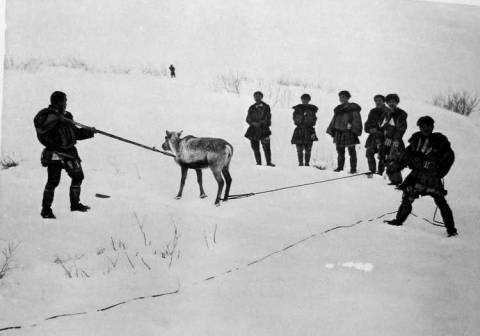
|
|
Fig.1 |
|
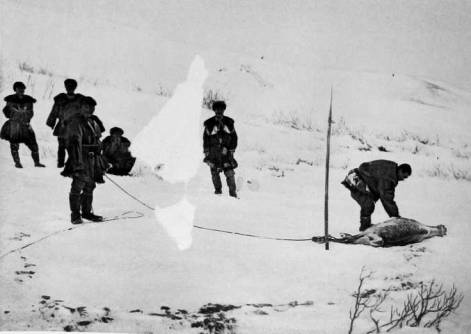
|
Fig. 2
|
Sacrifice
of Reindeer.
The Kopyak.
Jesup
North Pacific Expedition, Vol. VI.
Plate XI.
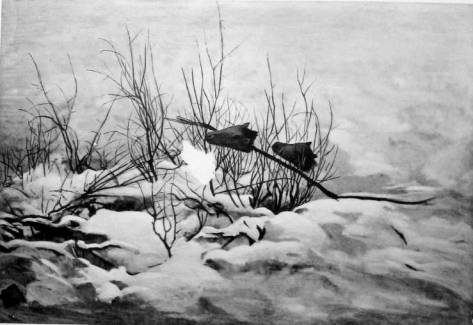
Fig. 1.
Sacrificial Heads of Reindeer-Fawns.
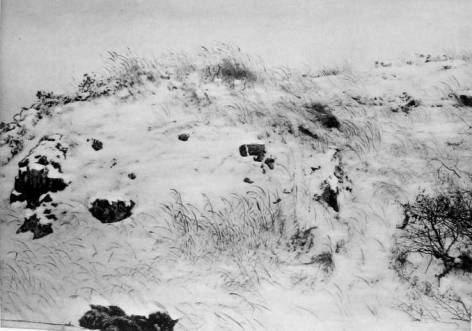
Fig. 2.
Sacred Hill.
The
Koryak.
I 2 1
JOCHELSON, THE KORYAK.
man
even if he were not a shaman, what ailed him when he was sick, or explain a dream to him, or show him the upper world or the underground world, or foretell what
would happen to him."
The Koryak
tales, as well as my
other records of Koryak beliefs, offer but scant material relating to
their ideas of the creation of the world.
According to the Kamchadal traditions,1 Raven (Kutq) created
the earth;
according to one of them, he made it out of his
son Simskalin; while another states that he carried the earth down from the sky with the help of his
sister, and set it firmly in the sea. In the Koryak tales,
only one name is met with which has any relation
to the creation of the earth : it is that of
Earth-Maker (Tanu'ta), who married Big-Raven's
daughter.3 The Koryak ideas of the form of
the universe are also very vague. The Chukchee believe that there are nine worlds, one above the other.3 The Koryak, like the Bella
Coola Indians, think that there are five worlds;
namely, our earth (Nuta'lqen), two worlds above it, and two below. The lower of the two upper worlds is inhabited
by the Cloud people (Ya'hala'nu);
while the upper one is the abode of the Supreme Being. Of the underground worlds, the upper one is inhabited by the kalau;
and the lower, called Enna'nenak or Ne'nenqal ("on the opposite side,"
"yonder"), is occupied by the
shades of the dead, the Peni'nelau ("ancient people").
According to some informants, there is still another underground world, the one nearest to the earth, inhabited by people like those living on
earth.4 From other informants I was led to conclude that
the two upper worlds are merged into one, which is inhabited by the Supreme
Being and the Cloud-Dwellers (I/ye-nimyi'sasn,
"inhabitants of the heaven village"). The lower worlds are also merged into one, lower village (taivivo'laken), in which there
are separate sections for the kalau, the dead, and
other inhabitants.
The underground kalau ascend from their world to our earth, and reach the lower world again, through the hearth-fire of human dwellings. The
dead descend to the world of shades through the fire
of the burning-place.
In the mythological age of Big-Raven, men could ascend to heaven, and get down into the underground world, with great ease. Now only shamans are capable of doing it. The kalau and other spirits have become
invisible to common people, and their arrows
can be discovered only by shamans. On the other hand,
there are tales according to which men who visit the underground world are invisible to spirits. This calls to mind episodes in
Indian tales relating to the arrows of men, which are
invisible to spirits.5 On the Kolyma River, I recorded an interesting
tale relating to this subject. It was told by a Yakut; but I am inclined to think that the story was borrowed
from the Yukaghir. "In
the winter a hunter fell into a crevice in the earth formed
1 Krasheninnikoff,
II, p. 100.
2 See Tale
111.
3 Bogoras, Chukchee
Materials, p. XII.
4 See Tale
110.
5 Boas, Indianische
Sagen, pp. 87,
94, 99, 149, 19°, 238, 254, 289.
l6—JESUP
NORTH PACIFIC
EXPED., VOL.
VI.
122
JOCHELSON, THE
KORYAK.
by
the frost,l
and got into the
underground world.
There he found Yakut people,
like those on earth. They
had the same kind of horses, just the same horned
cattle, the same kinds of houses, stalls, and storehouses ; and the people were
just the
same. He
went into
a house, and found the
people eating. He
greeted them; but, instead of responding to
his greeting, the host looked about
the house,
and said,
'What kind
of an abasy' (evil spirit) is talking here?'
Thus the new-comer discovered that he was invisible.
As he was very hungry,
he went up to the table and helped himself to meat, fish, and frozen cream
out of dishes and wooden plates that were standing there, so that their contents
disappeared rapidly.
The host
scolded his
children for
eating so much,
saying that
everything was
disappearing very quickly.
One of these children
was a pretty young girl.
Having satisfied his hunger, the Yakut sat down
near her,
embraced her,
and, following the Yakut
custom, smelled ot her.
All of a sudden the
people noticed that the girl began to writhe, and that
she had
an hysterical fit.
As soon
as the Yakut left her
alone, she quieted
down. At
night he
lay down by her side, and
when he embraced her
she again
fell into
a fit.
On the next day a shaman was
called, who donned
his attire
and began
to beat the drum.
Then the Yakut sat down near the girl and embraced her, and
again she writhed and screamed.
Suddenly the shaman said,
'I see!
it is a spirit from the middle earth above us, who is strangling
her.' He made his
conjurations, and finally entered into negotiations with
the Yakut, asking him what he would like to have to leave the girl alone. The
Yakut replied that he would leave the place if they gave him a black fox. The
shaman gave
him the fox,
and exorcised him.
Then he took him out of the house and
showed him
how to get out to the earth:
and thus, after prolonged
wandering, the Yakut returned home
and told of his experience."
The
luminaries are supposed to be beings of the same kind as men. As
stated before, the Sun (Ti'ykitiy) is regarded as a deity, and is
frequently
identified with the Supreme Being; but in the tales he is regarded rather
as
a country inhabited by the Sun people, particularly by Sun-Man, his
daughter and
son.2 In the incantation on p. 62 a woman of the country of
the dawn is
mentioned who is regarded as the sun. On the other hand, it is told that
the Sun was swallowed
by the raven.3
In some tales the Moon is described as a man ;4 in
others, as a woman 5 whom
Eme'mqut takes for his wife.
In still another tale we meet with a Star-Man.4
I recorded the following names of stars :
—
1.
Ursa
Major, Elwe'kyeñ
("the wild reindeer-buck") and Elwe'eñen ("wild reindeer
star").
2.
The
Pleiades, Ke'tmet ("little
sieve").
1
In
the cold
of winter,
when there is little snow, the surface-soil cracks, and forms wide rents,
which
in spring are washed out by the melting snow, and become
regular ravines.
2
Tales
12, 21.
3 Tale 82.
4 Tale
114.
5 Tale 29.
123
JOCHELSON, THE KORYAK.
3. Capella
in the
constellation of
Auriga, Yeke'nelaqlin
("driving with
reindeer").
4.
The belt of Orion,
Ena'nvenanana ("the handle of a scraper")
or Ulvei- yinitila'n
("he who carries the bow across").
5
The Polar Star,
Acka'p-ana'i ("nail-star").
6
The Morning Star, Pe'geten ("suspended breath").
7.
The Milky Way, Ya/veyem
("clay river").
Fig. 58 represents a map of the starry sky drawn by the Koryak Ace'pin of Kamenskoye. In
addition to the Milky Way,
he seemed to know the fol-
|
lowing
constellations and stars only: (1) Ursa Major, (2)
the Polar Star, (3) the Pleiades, and (4)
Orion. Besides, the last two constellations
are placed on the left side of his map, instead of on the right. Apparently Ace'pin,
who drew that map, made a mistake when
transferring the stars from the vaulted sky
to the
map.
The wind and the fog are also regarded as
men living in settlements. Thus Wind-Man is called
Kitfhimhla'n or Kitiy-ni'myisasn
("inhabitant of the village of the winds"); while Fog-Man is called Yina'mtilasn, and Fog-Woman, Yina'm-na'ut.
|
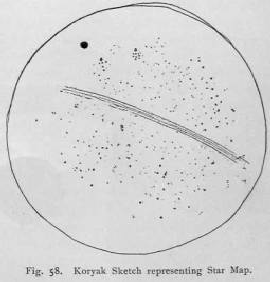
|
There is no doubt that the
primitive views
of nature held by the Koryak are gradually breaking down. In spite of the fact that the Koryak come in contact only with the lowest
representatives of Russian civilization, and
that even the formal side of Christianity is being adopted by them very slowly, the new ideas presented in the mode of
life of the Russians are destroying the Koryak
beliefs at an ever-accelerating rate. Their religion is
dwindling down to the mere observation of rites and of
taboos the meaning of which is gradually being lost;
and their religious myths are changing into
meaningless tales and fables, or are being forgotten entirely.
It is very interesting to note that a critical attitude toward the
ancient customs does not find equal expression in all places. For instance, the
Reindeer Koryak of the Taigonos Peninsula have
assumed a critical attitude toward the sacred fire-board. Their official chief
told me that he has no longer a sacred fire-board, that he prefers to have real shepherds for his herd. He
considers the drum, however, not only
a family guardian, but also the guardian of the nerd. I
was unable to acquire for the collection an old drum from the Taigonos
124
JOCHELSON,
THE KORYAK.
Koryak.
In Kamenskoye the sacred
fire-board is still treated with respect; but
the significance of the drum as a sacred heirloom of the family has declined, and
I was
able to acquire drums for the collection,
all of which are
ancient family
drums. I
have said before that
indifference toward old customs may be
observed more clearly in places
nearer Kamchatka than in those near the Russian
settlement on the
Gishiga River. Near
Kamchatka, for instance, in Kamenskoye,
families may
be found,
which, though
not baptized, show an inclination
to acquire
Russian customs. There
are a
few such
families in Kamenskoye.
They try to establish friendship with the Russians, and criticise their
own customs without constraint.
Thus the old man Yulta told me, as a proof
that dog-sacrifices do not serve any useful purpose, how his people were once
chasing in a skin boat after a whale, and could not come near enough to throw
the harpoon. Then
they killed a dog as a sacrifice; but the whale got still
farther away
from them. His
scepticism, however, did not
prevent him from
killing a dog the next day, on
the occasion of his son's departure.
In the
entire settlement, which consisted of thirty families, there is only one Koryak,
Oaci'lqut,
who has adopted Christianity.
To welcome a Russian he puts on a fur
jacket made after Russian fashion ; and
when he comes to a Russian house, he
makes the
sign of
the cross with an air of
great importance before the images
of the saints of the Greek Catholic Church without knowing, however, how
to fold
his fingers
properly. Nevertheless
he has two wives, and kills dogs
as
sacrifices to
The-Master-on-High.
When I
asked him once how it was
that he, a Christian, made dog-offerings, he replied, that since he became converted,
he killed only puppies, but not large dogs.
This was a half-serious reply; it would seem
that he thus thought to reconcile the two religions.
All this,
however, tends to the destruction of
the former religion; and were it not for
the low
level of culture among
the Russian settlers themselves,
and the ignorance
of the local orthodox clergy, the Russianization of the Koryak would proceed
at a much more rapid rate than it does at
present.
According
to the census of 1897, 1 out
of a total of 7530 Koryak, 3387
were baptized; i. e., 45 per cent. They were distributed among the
districts
as follows :
—
|
Christians. |
Pagans. |
| Gishiga |
1416 |
3018 |
| Petropavlovsk |
1727 |
948 |
| Okhotsk |
244
|
0 |
| Anadyr |
0 |
177 |
Of course a great many of
the baptized are Christians
only in name.
1 See Patkanov, p. 21.





